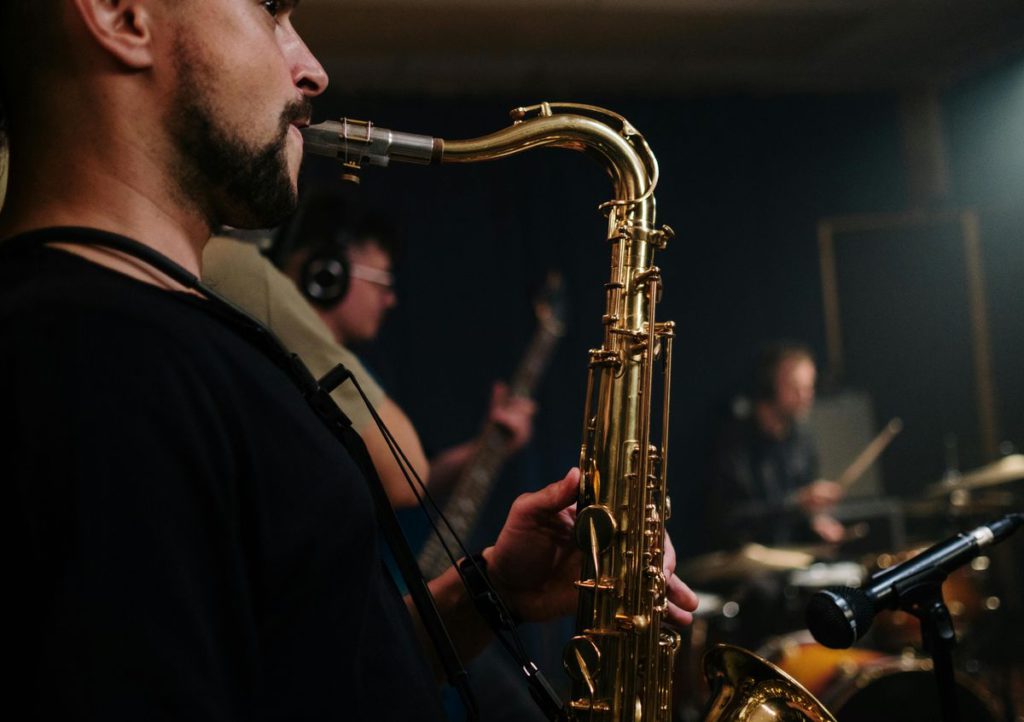
Jazz chords function as revolutionary acts in a world built on sonic conformity. These harmonic interventions have fueled everyone from Nina Simone dismantling racial barriers to Robert Glasper redefining Black music, each voicing a deliberate challenge to established power through seemingly simple finger positions.
Musicians who rely on basic triads remain trapped inside colonial harmonic frameworks while missing the cultural insurgency happening right beside them. The gatekeepers want your compositions safely contained within predictable structures.
13. Dominant 7th Chord (Unaltered)

The Dominant 7th serves as the harmonic equivalent of that friend who shows up at exactly the right moment to push you toward necessary change. Made of a root, major third, perfect fifth, and minor seventh, this chord carries inherent tension– a built-in demand for resolution that echoes how marginalized communities consistently pressure societal structures toward justice.
Music theorists with fragile egos might call this chord “basic,” but that dismissal resembles how establishment critics initially rejected punk, hip-hop, and electronic music. The unaltered dominant represents raw potential energy – the launching pad for every harmonic subversion worth attempting.
It resolves to chords a perfect fourth higher with the inevitability of dawn following darkness. Before exploring altered dominants, master this fundamental form of harmonic tension in all twelve keys. The revolution begins with fundamentals.
12. Major 7th Chord

The Major 7th chord functions as the secret rebel base of jazz harmony that even Star Wars’ resistance fighters would envy. While the patriarchy of traditional music theory tries convincing beginners that this chord sounds “too jazzy,” it’s the sonic equivalent of the first sip of good coffee after a lifetime of instant.
It’s built from a root, major third, perfect fifth, and major seventh, parts that combine to create something that sounds simultaneously stable and yearning.
Women composers have historically deployed this chord to subvert expectations in an industry designed to minimize their contributions. Try playing it as the I chord in a progression, but notice how it refuses to sound settled, almost requiring further harmonic movement.
11. G7 Chord (G7 with 13 and 9)

When standard G7 chords feel as predictable as superhero movie plots, the G7 with added 13th and 9th arrives as the harmonic equivalent of Tarantino subverting an entire genre. This sonic rebellion stacks G, B, F (the core dominant structure) with E and A, creating tension and resolution simultaneously.
The industry keeps pushing the narrative that extended dominants are “too complex” for regular folks, maintaining artificial barriers to musical liberation.
Notice how dropping the fifth (D) makes space – a lesson in how removal sometimes creates more impact than addition. Women instrumentalists have often deployed extended dominants to demand recognition in jazz scenes designed to minimize their contributions.
Use this chord as the V in a progression to experience how these extensions create momentum that basic dominants can only dream about.
10. D Minor 9 Chord

The D Minor 9 enters sonic landscapes as subtle resistance, adding unexpected layers to familiar territory, similar to how Jordan Peele transformed horror by injecting racial commentary into Get Out. This chord combines D, F, A, C, and E, though players routinely omit the fifth, recognizing how power structures often need their middle layers removed. The resulting sound carries emotional weight that basic minor triads simply cannot access.
Patriarchal music education systems rarely emphasize minor extensions, treating them as afterthoughts when they contain profound emotional complexity. This chord serves perfectly as the ii in minor progressions, creating tension screaming for release.
The next time rock purists claim jazz chords lack emotional directness, hit them with a properly voiced Dm9. Its moody introspection transforms predictable progressions into statements of unexpected depth. Sometimes revolution happens in whispers before the shouts.
9. F Major Chord (F with 9 and 13)

Complex major extensions get treated like outsider art in mainstream music scenes – acknowledged but rarely centered. The F Major with added 9th and 13th delivers harmonic revolution through shimmering brightness that transforms standard progressions into something resembling that moment when Dorothy first steps into Oz’s technicolor landscape. This structure combines F, A, C, G, and D, creating harmonies that refuse to be ignored.
Female jazz pianists have historically gravitated toward these extended major sounds, perhaps recognizing how these voicings create space for complexity within seemingly simple structures, much like how women navigate systems designed to minimize their contributions.
Try using this chord to replace standard F major and notice how the progression suddenly develops emotional depth previously unavailable. The added extensions aren’t mere decoration – they’re harmonic liberation from the tyranny of triadic thinking that keeps musical expression unnecessarily constrained within artificial boundaries established by conservative theory.
8. C Major 9 Chord

The C Major 9 isn’t just a chord – it’s the sonic equivalent of realizing the weekend has an extra day. This harmonic sunbeam combines C, E, G, B, and D, though many players rightfully exile the fifth to create breathing room.
The resulting sound manages to be simultaneously sophisticated and accessible, much like how Lizzo delivers complex social commentary wrapped in irresistible hooks. The music establishment has long tried to restrict extended major sonorities to elite contexts.
Pop producers deploy this chord whenever tracks need emotional lift without sentimentality. Try it as a tonic substitution when regular major chords sound as inspiring as corporate office small talk.
The extended harmonies create an uplifting quality that works particularly well in contexts requiring emotional authenticity. Next time someone questions why their music sounds generic, ask when they last explored major extensions.
7. A Dominant 7th Chord (flat 9 and flat 13)

The A7(b9,b13) delivers maximum sonic disruption – harmonic rebellion through calculated dissonance that mirrors how effective protest destabilizes complacent systems.
This altered dominant combines A, C#, E, G with the deliberately provocative Bb and F. The resulting tension doesn’t request attention – it demands it with harmonic urgency that mainstream theory textbooks rarely acknowledge, preferring to keep these sounds segregated to specialized contexts.
Film composers understand this chord’s power to create unease, deploying it whenever narratives require emotional disturbance. The establishment frames these altered dominants as “too complex” for regular consumption – another artificial barrier maintaining harmonic inequality.
6. Minor 9 Chord

The Minor 9 stands as harmonic resistance against emotional oversimplification – adding color where the mainstream prefers flatness, similar to how Michaela Coel’s I May Destroy You refused to deliver trauma narratives in expected packaging.
Combining a root, minor third, fifth, minor seventh, and major ninth, this chord creates emotions that basic landscapes minor chords cannot access. The music industry’s patriarchal structures have long marginalized these complex emotional expressions.
Players across genres weaponize Minor 9 chords when emotional honesty matters more than conformity. Try substituting standard minor chords with their Minor 9 counterparts and witness how progressions suddenly breathe with new life.
5. The Altered Chord (E7 Sharp 9 Sharp 5)

The E7(#9,#5) arrives like that scene in Pulp Fiction where expectations get violently rearranged – a sonic disruption that refuses to play by established rules. This altered dominant combines E, G#, and D with the deliberately provocative G and C, creating tension that demands resolution.
Often labeled the “Hendrix chord,” this harmony crosses genre boundaries while carrying cultural significance that mainstream music education routinely minimizes.
Women guitarists have reclaimed this sonority from masculine rock mythology, recognizing its power beyond clichéd uses. The establishment commodifies Hendrix’s innovations while isolating them from their revolutionary context.
4. Two Chords Played as a Dominant Nine Chord

Reharmonization stands as deliberate sonic insurgency – questioning why progressions must follow predetermined paths when alternatives exist, much like how Phoebe Waller-Bridge’s Fleabag broke fourth walls audience didn’t even realize existed.
Converting a ii chord to a dominant creates unexpected tension in familiar progressions, immediately disrupting listener expectations while maintaining forward momentum. This technique exposes how standard progressions represent choices rather than inevitable harmonic laws.
Women arrangers have frequently deployed these substitutions to transform the standard repertoire, though historical accounts routinely minimize their contributions. Try replacing minor seventh chords with dominant ninths in standard progressions and notice how the emotional trajectory immediately shifts toward greater urgency.
3. Minor 11 Chord

The Minor 11 chord enters harmonic conversations as subtle resistance against oversimplification, adding layers of complexity where mainstream theory encourages basic structures, similar to how Barry Jenkins’ Moonlight refused simple narratives about Black masculinity.
This extended harmony combines a root, minor third, fifth, minor seventh, ninth, and eleventh, creating emotional depth that basic chords simply cannot access. The resulting sound feels like a timeless track you want to hear on repeat.
Black jazz pianists pioneered these extended minor sonorities decades before they entered broader musical consciousness. Try substituting regular minor seventh chords with minor 11 structures and notice how progressions suddenly develop emotional nuance previously unavailable.
2. Major 13 Sharp 11 Chord (Two over One)

The Major 13(#11) exists as a harmonic dreamscape – a sonority so lush it practically forces emotional response, similar to how Wong Kar-wai’s cinematography creates unspoken emotional narratives through visual saturation.
This harmonic complexity combines a major seventh foundation with extended color tones, often voiced as different chords layered together (like D major triad over C bass). The resulting sound transcends simple categorization – simultaneously stable and searching.
Jazz education systems frequently gatekeep these complex harmonies, suggesting they belong exclusively to advanced players when they offer accessible pathways to sonic expansion. Try using this chord as a tonic substitution and notice how its Lydian character creates forward momentum even in static contexts.
1. Minor 2-5-1 Progression

The minor 2-5-1 progression stands as jazz’s emotional cornerstone – the harmonic equivalent of that pivotal scene in Parasite when the family descends stairs toward the unavoidable truth.
This progression moves from half-diminished to altered dominant to minor seventh, creating narrative tension and release that mirrors emotional storytelling. Mainstream music education often treats minor harmony as secondary to major, reflecting broader cultural patterns that marginalize expressions outside dominant paradigms.
Non-male jazz composers have historically explored minor tonalities with particular depth, perhaps recognizing how these harmonic landscapes accommodate complex emotional expression. Practice this progression in all keys, paying special attention to voice leading between chords.
The half-diminished ii chord creates initial tension, the altered V maximizes harmonic disturbance, and the minor i delivers resolution that nevertheless maintains emotional complexity. This progression doesn’t just move between chords – it creates complete harmonic narratives that demand emotional engagement beyond what simpler progressions allow.





















